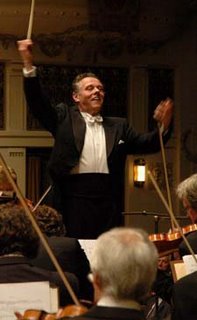 Latvian-born Mariss Jansons is one of the giants among classical conductors of our time and is more and more being widely recognized as such. After pioneering work for the Oslo Philharmonic and the Pittsburgh Symphony, he was named chief conductor of the Royal Concertgebouw Orchestra in Amsterdam, one of the oldest and most highly esteemed musical organizations in Europe. In his concerts and recordings, he has distinguished himself with innovative and stylistically sensitive readings, beyond the Russian repertory of his early training (at the Leningrad Conservatory). On Tuesday night, he brought his new group to the Kennedy Center for a much-anticipated concert sponsored by Washington Performing Arts Society.
Latvian-born Mariss Jansons is one of the giants among classical conductors of our time and is more and more being widely recognized as such. After pioneering work for the Oslo Philharmonic and the Pittsburgh Symphony, he was named chief conductor of the Royal Concertgebouw Orchestra in Amsterdam, one of the oldest and most highly esteemed musical organizations in Europe. In his concerts and recordings, he has distinguished himself with innovative and stylistically sensitive readings, beyond the Russian repertory of his early training (at the Leningrad Conservatory). On Tuesday night, he brought his new group to the Kennedy Center for a much-anticipated concert sponsored by Washington Performing Arts Society.Each half of the concert featured one longer work, beginning with Haydn's Symphony No. 94 in G Major and the classical core of the Concertgebouw group -- somewhat reduced numbers of strings and a few winds and percussion players. The first movement was a fairly calm and self-assured rendition of Vivace assai, in which the orchestra responded beautifully to the encouraging conducting of Jansons. His face was often smiling as he offered the players mimetic gestures to evoke smoothness, wonder, or whatever character he wanted. At times, he did not even give any tactus, just an expression, a leaning to one side, the signs of an appreciating ear. The musical response from the Dutch orchestra was lush, rhythmically united, uniformly articulated, and infectiously buoyant.
Of course, there is wit in Haydn, as mentioned in our review of Alfred Brendel's recital last week, but it does not need to be overemphasized. When we got to the fourth movement, with its sudden loud outburst from the timpani (cued playfully by just one of Jansons' fingers), we clearly understood why the "Surprise" Symphony got its nickname -- the work is sometimes known in German-speaking countries as the symphony mit dem Paukenschlag (with the timpani strike). Contrary to popular impression, the nickname "Surprise" does not come from the unexplained fortissimo blast near the beginning of the slow movement, which is also funny and in this performance was much more jarring than the actual "surprise." The Menuetto third movement became a boisterous beerhall dance in Jansons' hands, accompanied by a sweet sotto voce Trio. The fourth movement, conducted at a rollicking tempo with very minimal gestures, was a puckish whirlwind.

Richard Strauss dedicated at least one new work to the Royal Concertgebouw Orchestra and one of Mariss Jansons' predecessors as chief conductor, Willem Mengelberg: the elegiac masterpiece Ein Heldenleben in 1898. Supposedly inspired by Beethoven's Eroica Symphony but sharing only its key signature -- E-flat major -- with that work, this long and magnificent tone poem tells the story of an unnamed hero and his struggles.
Many have speculated that Strauss's great hero was none other than the composer himself, with the score's dissonant band of enemies corresponding to the critics who vexed Strauss with every new piece and the mysterious helpmate who assists the hero on his way to triumph representing the composer's beloved wife. (Critics should remember this story before savaging a young composer's new piece: you could end up the butt of a musical joke repeated in program notes ever after.) That Strauss quotes liberally from his own pieces in the "Works of Peace" section of Ein Heldenleben certainly seems to support the autobiographical interpretation. The association of this orchestra with the origins of the work added a new biographical layer to its story, and perhaps Jansons sees elements of his own life and career in its hero's victory.
Charles T. Downey, Early Valentine from the Royal Concertgebouw (DCist, February 14) Daniel Ginsberg, Jansons and the Concertgebouw: The Sound, the Fury & the Charm (Washington Post, February 15) Jens F. Laurson, Playful with Mariss Jansons' Toy (Ionarts, February 15) |
All in all, this was a startling and thrilling performance, with warm, cheerful Haydn playing (really good Classical style playing is not regularly heard here in Washington) and transcendent Strauss. The jangling, clamorous battle scene will remain in my ears for a long time. When the hero's melody rose up out of the orchestra, to triumph over his enemies, Jansons simply opened his arms and let himself be washed in the sound. There was no instrument in that vast array that presented anything other than rarefied sound. The delightful encore, the Andante Cantabile from the String Quartet in G Major, op. 3/3, Hob. III:15 -- the third in a set of six quartets once thought to be by Haydn and now generally attributed to Roman Hoffstetter as "Haydn's Serenade" -- was a study in understatement, just to show that those amassed strings were capable of something absolutely delicate, too. The smile on Mariss Jansons' face tells it all: yes, we can do that.
No comments:
Post a Comment